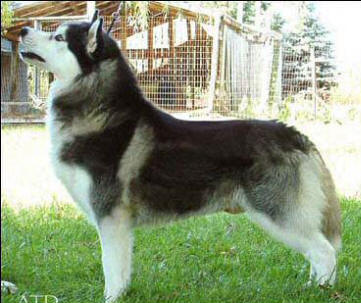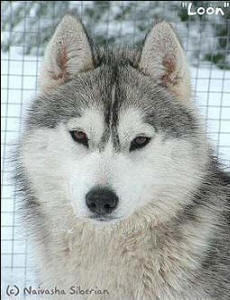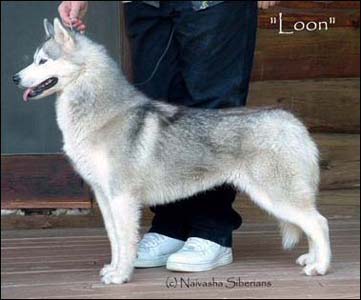GENERAL
CHARACTERISTICS:
The Siberian Husky has a delightful temperament, affectionate but not
fawning. This gentle and friendly disposition may be a heritage from the
past, since the Chuckchi people held their dogs in great esteem, housed them
in family shelters, and encouraged their children to play with them. Today
it is charming to observe the special appeal that Siberian Huskies and
children have for each other. The Siberian Husky is alert, eager to please,
and adaptable. His intelligence has been proven, but his independent spirit
may at times challenge your ingenuity. His versatility makes him an
agreeable companion to people of all ages and varying interests.
While capable of showing strong affection for his family, the Siberian Husky
is not usually a one-man dog. He exhibits no fear or suspicion of strangers,
and will greet guests cordially. This is not the temperament of a watch dog,
although a Siberian Husky may unwittingly act as a deterrent to those
ignorant of his true hospitable nature. If he lacks fierce possessive
instinct, he also lacks the aggressive quality which can sometimes cause
trouble for the owner of an ill-trained or highly sensitive guard dog. In
his relations with strange dogs, the Siberian Husky displays friendly
interest and gentlemanly decorum. If attacked however, he is ready and able
to defend himself. and can handle the aggressor with dispatch.
Care & Grooming:
The Siberian Husky is a comparatively easy dog to car for. He is by nature
fastidiously clean and free from body odour and parasites. He is presented
in the show ring well groomed but requires no clipping or trimming. At least
once a year, the Siberian Husky sheds his coat, and it is when armed with a
comb and a rubbish bin, that one realises the amazing density and profusion
of the typical Siberian Husky coat. Some people feel that this periodic
problem easier to cope with than the constant shedding and renewal of many
smooth coated breeds.
The Siberian Husky is noted as an easy keeper requiring a relatively small
amount of food for his size. That trait too, may be traced back to the
origins of the breed, as the Chuckchi developed their dogs to pull a light
load at a fast pace over great distances in low temperatures on the smallest
possible intake of food.
Habits:
Chewing and digging? Siberian Huskies have been know to do their share. The
former is a habit that most puppies of all breeds acquire during the
teething period, and it can be curbed or channeled in the right direction.
Digging holes is a pastime that many Siberian Huskies have a special
proclivity for, but in this too, they may be outwitted, circumnavigated, or
if you have the right area, indulged.
SHOW OR PET:
Siberian Huskies seem to get more and more popular every year. Because they
are a beautiful and intelligent dog, they have become a common sight in the
dog show ring.
There are two kinds of dog shows. One is the conformation show, where the
dog is judged on its physical appearance. The other is the obedience trial,
where the dog is judged on how well it carries out commands. If you think
you would be interested in showing your dog, attend several shows. This
should help you decide whether or not to get involved. The world of dog
showing can be quite exciting. But it is not for everyone.
A Siberian
Husky that is going to compete in the show ring must have excellent
conformation. The Canadian Kennel Club (CKC) has set the BREED STANDARD,
that is what the perfect Siberian should look like. A judge compares each
dog to this standard. The judge checks everything from slope of the dog's
nose to the curl of its tail.
Every dog that enters a conformation show must be a purebred registered dog.
There are shows open to all breeds of dogs. There are also specialty shows
for Siberians only. Earning points is the main goal of showing a dog in
Championship Shows.
In the
show ring your dog has to gait at your side. It also has to stand patiently
while the judge assesses it. A dog show can be a noisy, confusing place with
all kinds of smells and sounds. If your dog is used to crowds, it will be
more comfortable at its first show. If it isn't, a little socialising before
its first show with other dogs and people will help your dog to feel more
comfortable. The best way to learn about showing is to work with someone who
has been around the show scene or better still has experience showing
Siberian Huskies. A person like this can be a wonderful teacher. You can
also get information from the Canine Control Council (or equivalent) in your
state or contacting your local Kennel Club.
Many
people think that obedience trials are more exciting to watch than regular
dog shows. At an obedience trail, dogs perform a variety of command tests.
The sit, stay, drop, heel, jump hurdles and retrieve objects at their
owner's command. Siberian Huskies were not bred to compete in obedience
trials, but they do quite well in these competitions.
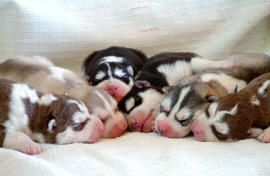
|
 |

|
(c) Naivasha Kennels 1994-2008
www.cynoweb.com Tous droits réservés.
|
|
-
We Have Currently Two Litters
"WE DO NOT TAKE ANY
RESERVATIONS BASED ON COAT OR EYE COLOUR"
Puppies born November
10th,
2008.
Co-Bred with
Éric
M. Lalonde Calahari Kennels
"WE DO NOT TAKE ANY RESERVATIONS BASED ON COAT OR EYE
COLOUR"
Puppies born November 21th,
2008.
CANADIAN CH.
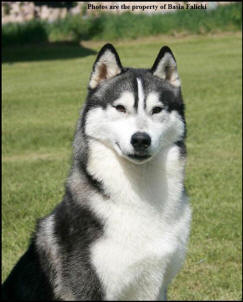 |
TUNDRAFOOT'S IT'S YOUR MOVE
 |
Second Litter:
Click on "this Link" to see all of them
CANADIAN CH.
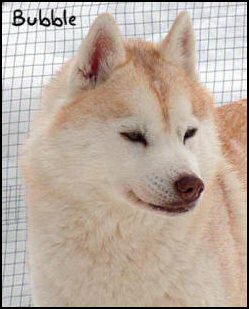 |
NAIVASHA'S VANITY FAIR
 |
|
Please contact me for early reservations.
Worldwide
delivery can be arranged
All my puppies are registered
with the Canadian Kennel Club, as well as
vaccinated, dewormed, tattooed.
Sur
Réservations (une éventuelle livraison peut être envisagée)
Tous
nos Chiots sont inscrits au Canadian Kennel Club,
Tatoués, vaccinés et vermifugés.

|
PURCHASING A PUPPY:
If you think you want a Siberian Husky, do some research before you
buy. Owning a Siberian can be a wonderful experience, but it also
takes a lot of hard work.
You should also have to consider where you live. Siberians can adapt
to fairly warm climates, they also love the colder areas. Once your
heart is set on getting a Siberian Husky you should decide whether
you want a male or female. If you want a show or pet Siberian. It is
simply a matter of choice. Of course you don't have to breed your
Siberian, a simple operation can fix this. You can find a good puppy
by visiting a registered Siberian Husky breeder. It's important to
find a breeder you can trust, so ask around and don't just go to
one. Check with The Siberian Husky Club in your state, local Kennel
Club or your local veterinarian.
When you buy a puppy from a breeder, you can learn more about its
background, you can meet one or both of the pup's parents. Your
puppy will probably look like its parents when it is an adult. It
may also have its parent's personalities. If its parents are
aggressive the puppy may be aggressive too. Siberian Huskies should
NEVER have this trait. Look for a puppy that is friendly, playful,
alert and healthy. Take it away from the other puppies in the litter
to see how it responds to you. Try calling to it or clapping your
hands, see if the puppy will follow you. Avoid choosing a puppy that
sits shyly by itself or slinks away. A puppy like this may be
difficult to train.
A puppy can go to its new home when it is 8 weeks or older. Make
sure your puppy has been checked by a veterinarian. Find out if it
has been vaccinated and dewormed, also if it has started Heartworm
treatment yet. All puppies should be on Heartworm tablets by 8 weeks
old. Ask the breeder what they have been feeding the puppy. If you
need to change the diet, do so gradually. A sudden change can make
your puppy sick.
When you take your new puppy home, it will need to explore its new
surroundings. It has to be watched closely so it doesn't get into
trouble. Remember the puppy is going to be excited. You will be
excited too! Try to be calm so that the puppy will soon settle down.
A puppy's first night in it's new home can be a hard one. It might
be lonesome and missing it's littermates. Put the puppy in a cozy
box or basket next to your bed. If it wakes up during the night and
is frightened, pet it soothingly. After several nights, your puppy
should be sleeping soundly. If it keeps crying during the night try
to ignore the cries, if it gets attention every time it whimpers,
the puppy will form the habit of whining to get the attention.
Always keep your dogs sleeping area clean whether it is inside or
out. Don't be surprised if your puppy sleeps a lot. Puppies grow
very quickly and use up a lot of energy. They need sleep to get that
energy back.
Never give your puppy sharp bones. Chicken, fish and pork bones are
very dangerous. They can splinter and stick in your dogs throat.
Rawhide bones or special nylon fiber bones make much better chew
toys. Plenty of fresh water should be available to your new puppy as
Siberians love to play in it. Change the water several times a day
and keep all water and food dishes clean.
Siberians love to run. Long walks, jogs or a game of fetch are a few
ways to exercise your puppy. A puppy can be taught several commands
when it is quite young. A few basic rules will help teach right from
wrong. Be consistent. If you find that you need some help with your
puppy in regards to certain things don't hesitate to contact the
breeder as they will be only too willing to help you.
CARING FOR YOUR PUPPY:
DEWORMING YOUR PUPPY FOR INTESTINAL WORMS.
A TYPICAL VACCINATION SCHEDULE IS
6 - 8 weeks - distemper, measles, parvo (DMP)
12 - 14 weeks - distemper, hepatitis, parvo (DHP). After that a once
yearly booster (DHP)
A pup is not fully protected until both needles have been given and
ideally should be kept away from other dogs and off the streets
until then. Protection of pups is a special problem : bitches immune
to DHP through previous vaccination have a protection level of
antibodies in their blood. These antibodies are passed onto the pup
through the first milk and give the pup limited immunity, but can
interfere with initial vaccination. This is one reason for the above
schedule.
DE-SEXING:
Ideally dogs that are not going to be used for breeding purposes
should be desexed around 6 months of age. Most breeds don't become
sexually active until they are 6 months old and there is no need for
them to have a litter, mate or come into season before desexing.
Female dogs that aren't desexed need to be fully enclosed for around
3-4 weeks every 6 months (they come into season on average twice a
year).
TAKING HOME YOUR NEW PUPPY:
Taking home your new puppy is a fantastic experience for Mums and
Dads as well as the kids and can provide years of enjoyment and
companionship for all concerned, but never forget that you have also
taken on a huge responsibility. It is up to you as the owner of your
new puppy to make sure that your puppy is well cared for. By
providing warmth, shelter, food, water, love and friendship many
years of happiness can be assured for both your and your puppy.
|




